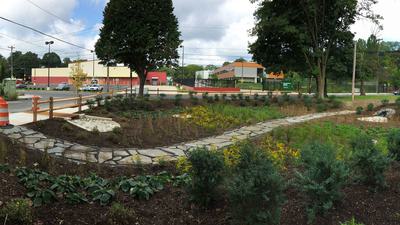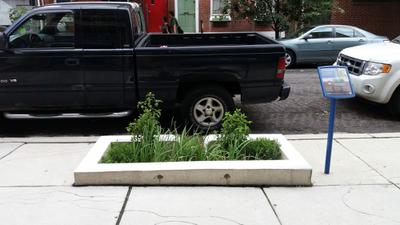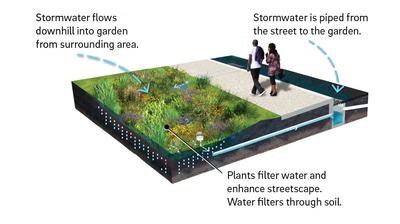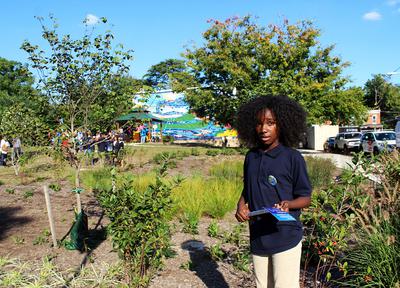New planters on Philadelphia sidewalks capture runoff from the streets. Philadelphia Water Department
Integrated into the city’s green spaces, streetscapes, and public and private buildings, this green infrastructure ranges from simple home rain barrels and downspout planters to complex bioretention swales underlain by drains, filled with sandy soil, and planted with resilient species of grasses, perennials, shrubs, and trees. Along with rain gardens, tree trenches, green roofs, and urban wetlands, this infrastructure will, as one study put it, “optimize and engineer the landscape” to mimic and restore its natural hydrologic regime. In the end, Philadelphia hopes by the mid-2030s to create the largest green stormwater infrastructure in the United States.
Philadelphia began by adopting and adapting technologies developed on smaller scales in other locales. In the early 1990s, Prince George’s County, Maryland, for instance, explored the use of bioretention — directing stormwater into small depressed landscaped areas where it could infiltrate and be filtered through soil and plants. The success of what were then called “low-impact development” designs in detaining runoff and removing contaminants of all kinds inspired green infrastructure efforts in other places. These local governments eventually realized the advantages, both financial and environmental, of green stormwater infrastructure.
Portland, Oregon began its stormwater control efforts in 1993 with a “downspout disconnection program” that encouraged homeowners to redirect roof water to gardens and lawns. These efforts have since expanded into a Sustainable Stormwater Management Plan that links city agencies in an effort to control runoff. Green stormwater infrastructure is a major component of Milwaukee’s “ReFresh Milwaukee” sustainability plan, designed to reduce pollutant loads into Lake Michigan. By 2035, Milwaukee plans to capture the first half-inch of rainfall during any given storm on the city’s 43.7 square miles of impervious surface. In 2013, Seattle set a goal of using green stormwater infrastructure to control 700 million gallons of stormwater runoff and created a program called RainWise to encourage homeowners to install rain gardens and cisterns.
In Europe, cities concerned with increasing numbers of heavy storms have instituted green solutions, such as Copenhagen’s Cloudburst Management Plan, which is creating 300 catchment areas throughout the Danish capital to retain and release stormwater. China, where rapid urbanization has caused major problems with stormwater and sewage runoff into waterways, has begun a green stormwater management program called “Sponge City” in 16 municipalities.
WATCH: Philadelphia innovates on green infrastructure
In Philadelphia, the measure of the city’s progress is a “greened acre.” Each acre of the city receives some 1 million gallons of rainfall annually. Once “greened,” an acre of impervious surface will have its first inch of runoff managed by stormwater infrastructure and the pollution from that acre sharply reduced. The city plans to create roughly 10,000 of these acres. To date, the Philadelphia Water Department has built nearly 1,100 greened acres and expects to add another 1,300 in the next three years; the green infrastructure already is exceeding targets for stormwater overflow reduction, cutting that volume by 1.7 billion gallons — nearly three times the original projection.
Proponents maintain that the cumulative effect of all these new green microhabitats is not only to contain stormwater, but to reverse the city’s graying nature by creating rain gardens, small parks, green roofs, and similar amenities. Not only does this infrastructure slash water pollution, ameliorate air pollution, and reduce the urban heat island effect, but it also has social and economic benefits.
Nancy Stoner, now a senior fellow at the Pisces Foundation, an environmental non-profit, was influential in developing Philadelphia’s green stormwater initiative in her former roles at the Natural Resources Defense Council’s water program and the EPA’s Office of Planning and Policy Analysis. The program was never solely about slashing combined sewer overflow, she recalls, but also about providing larger environmental and social benefits.
“Philadelphia wanted to do much more,” Stoner says. “They did a benefits analysis before they began that showed it would enhance air quality and climate resiliency. It takes the problem of stormwater and turns it into an amenity.”
The Philadelphia Water Department has taken the lead in the project through its Green City, Clean Waters initiative. Since one green acre is as valuable as another, Water Department workers have been installing green stormwater infrastructure projects in a range of public areas, focusing on neighborhoods with little or no green space.
Panati Playground, for instance, occupies half a block at the corner of North 22nd and W. Clearfield streets in a low-income, mostly African-American neighborhood known as Allegheny West. Neighborhood associations had done their best to maintain the little park that had, like the surrounding neighborhood, been underserved by the city as factories left and housing vacancies increased.
The neighborhood was built on land created when the city, in 1860, culverted Cohocksink Creek, which the Board of Health had called “a prolific source of miasma.” So it seemed a fitting place to build green stormwater infrastructure and also make the park an improved neighborhood amenity. The Water Department, working with the Parks & Recreation Department, rebuilt the playground, and instead of just putting in new swings and slides, surrounded the play zones with infiltration trenches to convey and contain runoff, constructed rain gardens planted with grasses and perennials, and installed planters of white oak.
The $227,000 investment not only gave the neighborhood a revitalized public space where kids could play within a much-needed greened environment, it also stores 2,700 cubic feet of stormwater from a 37,000 square foot drainage area. The result: three quarters of a greened acre.
At the Waterview Recreation Center in the city’s Germantown neighborhood, the Water Department, working with the Parks Department and the Pennsylvania Horticultural Society, added half a greened acre by installing tree planters, downspout planters, and porous concrete sidewalks over gravel infiltration beds to drain water from a 13,000-square-foot area.
In six years, the Water Department, collaborating with environmental groups and civic associations, has completed 152 publicly funded green stormwater infrastructure projects. Some 300 more are in the works in schools, parking lots, parks, and on rooftops. The department has developed a “GreenSTEM” network that engages students in environmental monitoring and data collection. It has initiated a Green Homes project, put together handbooks for developers and contractors, and is working with an AmeriCorps group to engage 18- to 26-year-olds to collect litter and leaves from green infrastructure sites.
This rain garden in West Philadelphia helped transform a formerly vacant lot into a community gathering place. Philadelphia Water Department
But green acres on public property alone — at an estimated cost of $250,000 to $300,000 for each greened acre — won’t get the city to its 25-year goal of 10,000 greened acres. That will require a great deal of private green infrastructure. Plenty of impervious surfaces are available to retrofit, from large parking lots to extensive rooftops. The Water Department is offering private owners and developers a mix of financial incentives, ranging from outright grants to reductions in stormwater fees, which are levied by the city to cover the cost of handling stormwater runoff.
Of the 1,073 greened acres completed in Philadelphia by the end of 2017, 226 were on public property and 847 on private property; nearly 500 of the privately converted acres were “greened” through redevelopment of the properties or a program of incentivized stormwater retrofits.
For example, Cardone Industries, a manufacturer of auto parts, is taking advantage of a Stormwater Management Incentives Program grant to green its 69-acre property in Northeast Philadelphia. The company is planting swales and detention basins both above and below ground that will manage 5 million gallons of runoff a year from its parking lots and 22 acres of roof. In exchange, the city gives Cardone a $250,000 annual break in stormwater fees.
On the west side of the Schuylkill River, near the University of Pennsylvania, a 1.25-acre roof atop an 11-story parking garage at the Cira Centre South provides not only stormwater management, but an elevated public park. What makes possible the roof’s extensive plantings and long, sloping lawns is that this green roof is also a blue roof, meaning it holds rainwater in retention cisterns and gradually releases it into the surrounding green roof. All this happens while people picnic on the roof, attend concerts, or take in the spectacular views of Center City Philadelphia and the Schuylkill River.
A key aspect of Philadelphia’s green stormwater infrastructure plan is the realization that it will take decades to turn the situation around and re-establish some semblance of ecological balance in the way this city of 1.6 million handles rainfall.
WATCH: A living laboratory for green infrastructure
“I hope the big lesson is that this is not something that you do overnight,” said Howard Neukrug who served as the city’s water department commissioner from 2011 to 2015. “It’s a slow evolution of a city, that says, ‘Okay, here we are today in 2018. What do we want the city to look like in 2022? What’s the quality of the rivers, how are our communities built, and how are our assets paid for?’”
Indeed, the “Green City, Clean Waters” program has been decades in the making. A 1987 amendment to the 1972 Clean Water Act led the EPA to order Philadelphia to drastically reduce its combined sewer and stormwater overflows. Most of the 300 miles of streams that once ran through the city had been channelized into a 3,000-mile sewer system. Even small storms overwhelmed (and still overwhelm) the capacity of the city’s three sewage treatment plants, which meant that a combination of stormwater and sewage would have to be diverted from the treatment plants and dumped directly into the Schuylkill and Delaware rivers.
A total of 16 billion gallons of untreated runoff gushed out of the city annually, eroding remaining stream banks, wrecking fish habitats, and carrying fecal coliform bacteria, petroleum products from the streets, and heavy metals, such as lead and zinc, into rivers. The intakes of Philadelphia’s drinking water system were downstream of these discharges.
Neukrug, who in 1999 became director of the Water Department’s Office of Watersheds, recalls that initially the solution seemed to be more engineering: Find more ways to speed the water off the streets and into the sewers, and divert whatever the treatment plants couldn’t handle into large underground tunnels, where it could be held and, then, once the rains ended, pumped out for treatment. But Neukrug says the tunnel plan — the ultimate gray infrastructure megaproject, with a central, 34-foot-diameter, 30-mile-long tunnel — would have taken 15 to 20 years to build, would have torn apart streets and parks across the city, and would have cost a fortune.
“It was a $10 billion tunnel and we didn’t have $10 billion,” recalls Neukrug. “We called it the ‘100-year tunnel’ — not for how long it would take us to build, but for how long it would take us to pay for it. The environmental costs were high and in the end you’re not getting a new train tunnel or highway bypass or maintaining your infrastructure or drinking water supply — you’re getting something for collecting rainwater and sewage.”
Heavy rainfalls, such as Hurricane Irene in 2011, have overburdened Philadelphia sewers causing untreated waste to flow into the Schuylkill River. Neil McManus/Flickr
The answer, in the view of Neukrug and others, was to somehow change the scale of the solution. Other cities, such as Chicago, were committing themselves to multi-billion-dollar gray infrastructure projects. But Neukrug and officials in Philadelphia were intrigued by a growing green infrastructure movement that favored new low-impact development designs.
At nearby Villanova University, the Urban Stormwater Partnership, founded in 2002 under environmental engineering professor Robert Traver, had begun experimenting with green stormwater infrastructure. Neukrug developed a couple of low-impact pilot design projects, and in 2009, the Philadelphia Water Department released a revision — 12 years in the making — to its stormwater and sewage management plan. Dealing with sewer overflows would be only one part of an expansive plan to integrate management of the city’s watersheds, develop a network of green stormwater infrastructure on public land, establish requirements and incentives for building green infrastructure to manage runoff on private lands, preserve open space to manage stormwater at its source, restore streams, and upgrade treatment plants.
The city is working now to standardize the construction of green infrastructure and monitor its effectiveness. Costs are coming down as green infrastructure becomes more widely adopted.
“We have to work better, faster, and at a lower cost,” said Marc Cammarata, the Water Department’s deputy commissioner of planning and environmental services and a former student of Robert Traver’s at Villanova.
As the Water Department’s planners expand the network of greened acres, they are bringing social, economic, and environmental investment to often marginalized neighborhoods. Cammarata says that green stormwater infrastructure projects now support 430 jobs. A study by the Sustainable Business Network projects a $3.1 billion economic impact over the first 25 years of Green City, Clean Waters. Residents already report that green infrastructure projects have reduced crime as green spaces proliferate, says Cammarata.
The Water Department’s website map is crowded with green infrastructure sites across the city. Visitors can zoom in on their neighborhood and see what’s there. But a thousand green acres means the city is only about a tenth of the way toward its goal.
Still, Cammarata told me, “It’s working. We’re changing the way you do sustainable development in a city.”







